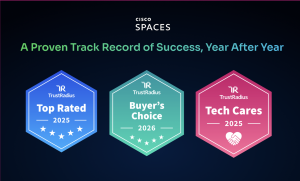
The hybrid workplace is reshaping the way organizations function, combining the flexibility of remote work with the benefits of in-office collaboration. Designing an effective hybrid environment requires a thoughtful approach to meet the needs of both employees and businesses. Let’s explore key strategies and valuable insights to hybrid workplace design that drive productivity, innovation, and connection.
The Hybrid Work Model in 2025
Today, the hybrid work model is a dynamic blend of remote and in-office work. Many employees follow split schedules or choose flexible days to come into the office. All of this has led to reduced desk-to-employee ratios, with companies shifting toward shared or hot-desking setups. This model has become the default across several organizations, emphasizing flexibility and autonomy for employees. As a result, businesses are reimagining their workspaces to be smarter, more adaptive, and better equipped to align with changing workforce needs.
What Is Hybrid Workplace Design?
Hybrid workplace design is the strategic approach to creating environments that support the unique needs of both in-office and remote employees. It goes beyond furniture and floor plans. It integrates layout, policies, and technology to enable seamless collaboration and productivity in hybrid workflows. By blending physical spaces with innovative tools and flexible guidelines, this design model ensures employees can work effectively from anywhere. All of this while fostering connection when on-site. The goal is to create dynamic workplaces that adapt to the evolving demands of modern, hybrid teams.
Benefits of a Hybrid Work Environment
Empower Greater Employee Productivity
Hybrid workplace design empowers employees by offering the flexibility to choose environments that suit their tasks, such as quiet zones for deep focus or collaborative spaces for teamwork. This freedom enables individuals to align their workspace with their specific needs, creating optimal conditions for productivity. By providing tailored options, hybrid design enhances both efficiency and employee satisfaction.
Enhance Employee Satisfaction & Experience
Hybrid workplace flexibility fosters increased autonomy and trust, allowing employees to manage their time and environment according to their preferences. When individuals have control over their work conditions, it enhances their engagement and commitment, often resulting in greater job satisfaction and loyalty. By aligning workspaces with employee needs, companies can build a more positive and supportive organizational culture.
Promote Healthier Work-Life Balance
Hybrid work promotes healthier work-life balance by reducing commute stress, enabling better personal time management, and lowering the risk of burnout. While the physical office remains essential, it should be designed to make on-site work feel purposeful and energizing. It should also offer spaces that inspire collaboration and focus. This approach helps employees balance their professional and personal lives more effectively, fostering overall well-being.
Foster Stronger In-Person Collaboration
Hybrid work doesn’t diminish collaboration; instead, it makes in-person time more intentional and meaningful. A well-designed workspace fosters interactions, facilitates team rituals, and supports scheduled deep collaboration, creating opportunities for genuine connection and creativity. By aligning physical spaces with collaborative needs, hybrid design strengthens team cohesion and leverages the best of both in-office and remote work.
Attract and Retain Top Talent
Providing a flexible and thoughtfully designed hybrid experience has become a core expectation for today’s workforce. Companies that invest in smart, employee-first office design demonstrate adaptability and a strong workplace culture, both of which are vital for attracting and retaining top talent. This commitment signals to employees that their needs and well-being are prioritized, enhancing organizational appeal and loyalty.
9 Strategies for Hybrid Office Design
1. Adopt Flexible Desk Sharing
Assigned seating is often inefficient in hybrid environments. This leads to empty desks and wasted office space as employees don’t consistently work on-site. Flexible desk-sharing models like hot-desking or hoteling maximize space utilization while providing employees the flexibility to choose where they work. Smart Desking takes this a step further by allowing employees to reserve desks in real time using live floor maps. This makes the process seamless and user-friendly. Additionally, Smart Desking tools provide IT and workplace teams with valuable insights into desk usage trends, enabling them to optimize layouts and adapt to evolving workplace needs.
2. Optimize Meeting Room Usage
Many offices face the problem of ‘ghost meetings’, where reserved meeting rooms go unoccupied, waste valuable space and create frustration for employees seeking room availability. Implementing occupancy-based automation or check-in policies can drastically improve room usage rates by ensuring reservations align with actual use. Cisco Spaces, integrated with Collaboration Devices and smart sensors, automatically releases unused rooms if they remain unoccupied, freeing them for others. Additionally, the Meeting Room Finder feature helps employees instantly locate and book available rooms, streamlining the experience and ensuring productive use of meeting spaces.
3. Streamline Space Reservations
A single, intuitive system for reserving desks, rooms, and other spaces is critical to creating a seamless hybrid office experience. Booking friction, such as unclear processes or unreliable systems, can discourage them from returning to the office. Cisco Spaces provides unified tools that enable employees to make real-time bookings via web or mobile, offering a seamless experience backed by live floor maps of the office along with occupancy data. By simplifying the process of locating and booking rooms/desks, organizations can foster a more confident and productive return-to-office culture.
4. Enable Indoor Wayfinding
Navigating unfamiliar or large offices can be challenging, especially for hybrid or infrequent visitors who may struggle to locate desks, meeting rooms, or colleagues. This lack of familiarity can lead to wasted time and increased frustration, detracting from the employee experience. Cisco Spaces addresses this with its 3D maps and Indoor Wayfinding feature, offering turn-by-turn directions to help employees find their destinations quickly and easily. The best part is that this functionality works via app clip, without requiring a downloaded app, ensuring a frictionless and user-friendly experience for everyone.
5. Design for Varied Workstyles
Hybrid workers require access to diverse space types, such as quiet zones for focus work, collaboration areas for teamwork, and lounge spaces for relaxation or informal interactions. Intentional zoning of the workplace ensures that these varied needs are met, supporting employees as they transition between tasks and energy levels throughout the day. Cisco Spaces provides usage data that helps workplace teams analyze which types of spaces are most in demand, enabling them to optimize layouts and adjust zones based on employee preferences and trends. This data-driven approach ensures the office remains dynamic and responsive to the evolving workstyles of hybrid teams.
6. Automate Room Comfort
Employee productivity is closely tied to comfort factors like temperature, airflow, and lighting, as these environmental conditions can significantly impact focus and well-being. Manual management of these settings can be inefficient and inconsistent, whereas automation ensures spaces are optimized whenever occupied. Smart Rooms, powered by Cisco Spaces, detect occupancy and automatically adjust environmental settings to create a comfortable and productive atmosphere. When rooms are unoccupied, these smart systems power down, reducing energy waste and ensuring efficient space management.
7. Leverage Real-Time Data
Ongoing workplace optimization relies on real-time occupancy and usage data, rather than assumptions or outdated trends. Live data enables organizations to make smarter decisions about reconfiguring spaces, reducing underutilized areas, and scaling designs to meet evolving employee needs. Cisco Spaces offers powerful real-time analytics that provide visibility into key metrics, including space usage, zone performance, and occupancy patterns across buildings or campuses. These actionable insights help teams create more efficient, adaptable, and employee-focused environments.
8. Involve Employees in Planning
Involving employees in workplace planning is essential to ensure that spaces meet their actual workstyles and needs. By engaging employees through surveys, pilot programs, or ongoing feedback channels, organizations can better understand how their workforce operates and what they value in a workspace. This collaborative approach leads to more practical and effective design decisions, fostering a sense of ownership and satisfaction among employees. Ultimately, aligning workplace design with employee input creates environments that are both functional and empowering.
9. Unify Workplace Technologies
Managing multiple disconnected workplace tools, such as separate systems for booking, sensors, and analytics, can lead to inefficiencies, fragmented data, and high operational complexity. A centralized platform simplifies the management of hybrid workplace functionality, making it easier to scale and adapt to employee needs. Cisco Spaces offers a comprehensive solution by unifying sensors, booking capabilities, digital signage, automation, and real-time analytics into a single platform. Built on existing Cisco network infrastructure, it streamlines operations, reduces redundancies, and provides a cohesive view of the workplace, for better decision-making.
Why Cisco Spaces Is Ideal for Hybrid Teams
Leverages Your Existing Cisco Infrastructure
Cisco Spaces is designed to integrate seamlessly with existing Cisco network hardware that many companies already use, such as Cisco Catalyst, Meraki, and Collab. This eliminates the need for major new hardware investments. Businesses can simply activate the built-in capabilities of their existing infrastructure, making it a cost-effective and efficient way to modernize workspaces without starting from scratch.
Delivers Flexible, Scalable Solutions
Hybrid work environments are dynamic, requiring solutions that can scale and adapt. Cisco Spaces supports businesses of all sizes, from single buildings to global portfolios, and easily adjusts to changes in policies, occupancy patterns, or new space requirements. Its scalability and flexibility ensure companies can meet both current and future needs, making it a future-proof solution for hybrid teams.
Unifies Workplace Tools in One Platform
With Cisco Spaces, businesses can centralize critical functions like space booking, mapping, sensors, environmental automation, and analytics on a single platform. This eliminates the inefficiencies of juggling multiple point tools/solutions and provides a holistic view of the workplace. All systems work together seamlessly, enabling teams to optimize their spaces with ease.
Simplifies Workplace Management for Teams
Cisco Spaces simplifies hybrid workplace management by offering IT, facilities, and workplace teams an intuitive, unified platform. Real-time data, booking systems, environmental controls, and analytics are all accessible from one dashboard, removing the need for technical expertise or navigating multiple tools. This streamlined approach allows teams to better manage hybrid workspaces and focus on delivering positive employee experiences.
Bring Your Hybrid Strategy to Life with Cisco Spaces
Hybrid workplace design is a critical strategic response to the evolving nature of work, enabling flexibility, improving space efficiency, and supporting employee productivity. By leveraging data-driven insights and user-focused tools, organizations can create adaptable environments that meet both business and employee needs.
Cisco Spaces empowers businesses to bring these strategies to life by unifying essential functions—such as space booking, occupancy insights, environmental controls, and real-time analytics—into a single, scalable platform. This comprehensive solution simplifies workplace management while enhancing decision-making, making it ideal for hybrid teams.
To see Cisco Spaces in action, explore the Product Tour.


